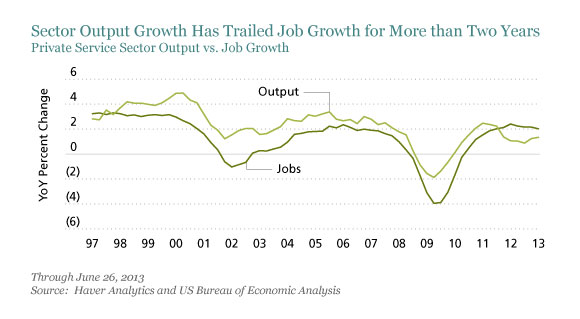First-quarter US economic growth data were revised downward today by the Bureau of Economic Analysis (BEA), based on new information suggesting a slower pace of consumer spending on services. The change draws attention to an anomaly between strong private service sector job growth and weak private service sector output.
The BEA lowered real gross domestic product growth for the first quarter to an annualized rate of 1.8%, from its previous estimate of 2.4%. Consumer spending on services was responsible for most of the change, as the BEA incorporated new information from the Census Bureau quarterly service survey. Before the revision, real consumer spending on services—ranging from housing and healthcare to recreation and education—rose by 3.1% in the first quarter. After incorporating the new data, the growth rate was cut to 1.7%.
We were surprised by the change because it appears to contradict job growth figures for the private service industry. Yet the disconnect between private service sector output and job growth in the first quarter was not unique. This trend has been apparent for more than two years.
Historically, job creation in the private service industry has generally served as a good proxy for output growth, as the display below shows. The recent shift, in which private service sector output growth has trailed private service sector job growth, is hard to explain. The service sector has always been labor intensive, because people are needed to deliver services, whether in hospitals or transportation. Over the past decade or more, technology has played a bigger role in services, especially in healthcare, transportation and finance. But greater use of technology in services suggests that the rate of output growth should run above—not below—the increase in jobs.

Indeed, companies across industries are keen on becoming more efficient. However, the trends in private service sector output and job growth suggest that productivity is declining and earnings are weakening, which should lead to less hiring and even job cuts. Yet private service sector job creation has been running consistently at about 170,000 per month for two years and service industry profits have been growing modestly.
It is hard to say with any certainty why the output and job figures for the private service industry are diverging, but one possible explanation is that the Census Bureau quarterly report on service industry revenue is understating output growth. The BEA will update the GDP figures several times in the years to come, and we would expect the final data to show private service sector output growth to be more in line with the pace of job creation.
In the short run, however, we think the job numbers still offer a good assessment of business activity, as they reflect what businesses are doing and experiencing in the real world.
The views expressed herein do not constitute research, investment advice or trade recommendations and do not necessarily represent the views of all AllianceBernstein portfolio-management teams.